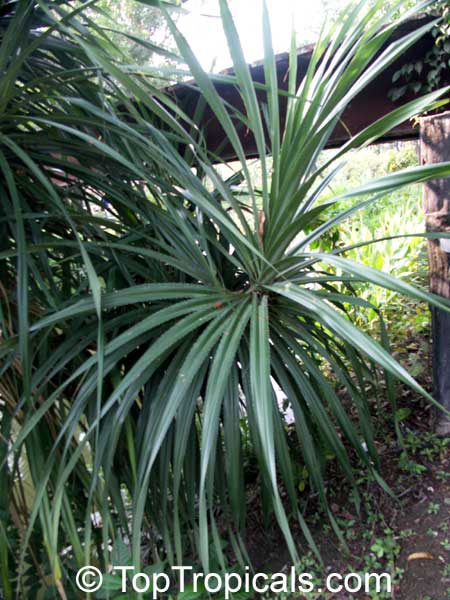Pandanus odoratissimus (Umbrella tree)
Top Tropicals Plant Encyclopedia
Botanical names: Pandanus odoratissimus, Pandanus fascicularis
Common names: Umbrella tree, Screw pine, Screw tree, Kewra, Kewda, Kewara
Family: Pandanaceae
Origin: South East Asia








Pandanus odoratissimus, known more commonly as umbrella tree, is a small tree that reaches between 10-20 ft in height. Native to South East Asia, this versatile plant is well suited for a variety of environments, ranging from full sun to partial shade. It is tolerant of both moderate water and drought, with Flood and seaside tolerance. Also salt tolerant, it can be grown near coastal areas.
The pandanus tree is most widely recognized for its fragrant flowers. The male inflorescence of this plant is used in the production of Kewra Water, a pleasantly perfumed, sweet water distillate that is a popular flavor agent used in desserts and drinks throughout India. The flowers of this plant are more fragrant and more powerful than even when dried out, making it an ideal plant for any garden.
Besides its fragrant appeal, the pandanus tree also offers a range of ethnomedical benefits. The root of the tree has been used for centuries in Southeast Asia for medicinal remedies, acting as a diuretic, expectorant and antipyretic. The male inflorescence can also act as a cardiotonic, strengthening heart muscles and circulation.
Hardy in USDA Zone 9-11, the pandanus tree is the ideal plant for both warm and cool regions. Planting in a well-drained, rich soil is optimal. Watering the pandanus should be done only when the soil is dry, as Plants are not tolerant of overwatering. When planted in a pot in colder climates, it should be brought in during cold weather as pandanus is not freezing tolerant. Finally, for maximum flowering, fertilizing with a high-nitrogen fertilizer will produce the best results.
Taking into consideration its pleasant aroma, ethnomedical benefits, and hardiness, it's easy to see why the Pandanus odoratissimus has become a popular plant for gardens around the world. Its beautiful, palm-like leaves provide an exotic and appealing appeal to any garden. With a little extra care and protection, you can be sure that this small yet hardy tree will bring you many years of pleasure.



